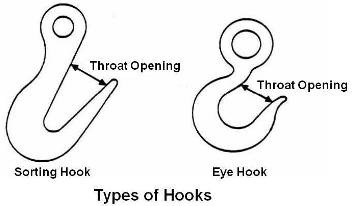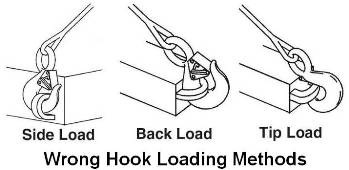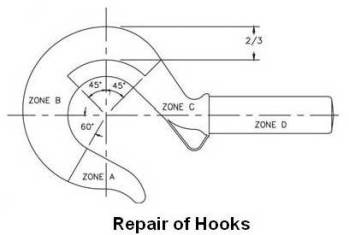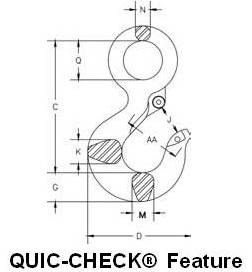Information about material, specification, marking and application for hooks and swivels is given in this article.
Hooks
Hooks are installed on cranes, hoists, etc. and are also used for rigging. Rigging hooks are used as part of rigging tackle, such as sling assemblies, or with below-the- hook lifting devices. They are available in carbon steel and alloy steel materials. They are made as per requirements of ASME B30.10 and Federal specification RR-C-271D.
A latch, or mousing, bridges the throat opening of the hook for the purpose of retaining slings, chains, or similar parts under slack conditions and is not intended to support the load. Latch equipped hooks shall be used for all hoisting and rigging operations unless the application makes use of the latch impractical, or unsafe.
Many styles of hooks are available. Two typical rigging hooks are shown below.

Some rigging hooks (e.g., sorting hooks) are designed to carry the load near the point/tip as well as in the bowl or saddle of the hook. The designated SWL applies only when the load is applied in the bowl or saddle of the hook. Generally forged alloy steel hooks are used as rigging hooks. The manufacturer’s identification shall be forged or die-stamped on the hook.
Application
Load shall be applied in the bowl or saddle of the hook.
Side loading, back loading and tip loading as shown below are conditions that damage and reduce the capacity of the hook.

Inspection
All hooks shall be inspected as per statutory requirements.
Service Classification for Hooks
Hooks fitted on cranes, hoists, etc. are classified based on service/use as under.
Normal Service: Service that involves operating at less than 85% of rated load except for isolated instances.
Heavy Service: Service that involves operating at 85% to 100% of rated load as a regular specified procedure.
Severe Service: Heavy service coupled with abnormal operating condition.
Hooks fitted on cranes, hoists, etc. having any of the following conditions shall be discarded.
- Deformation: Any bending or twisting visible to the inspector.
- Throat Opening: Any distortion causing an increase in throat opening exceeding 5% or as otherwise directed by the hook manufacturer.
- Wear: Any wear exceeding 10% of the original section dimension of the hook or its load pin or as otherwise directed by the hook manufacturer.
- Cracks: Any visible crack.
- Latch engagement: Damaged or malfunctioning latch (if provided).
- Nondestructive Testing: Hooks with a rated load greater than or equal to 10 tons and assigned to heavy or severe service shall receive an NDT by a qualified inspector.
Rigging hooks shall be visually inspected for the following deficiencies before use:
- Distortions such as bending, or twisting exceeding 10 degrees from the plane of the unbent hook.
- Increased throat opening exceeding 15%.
- Wear exceeding 10% of the original dimension.
- Cracks, severe nicks, or gouges.
- Hook attachment and securing means.
Rigging hooks shall be inspected as a part of the slings to which they are attached. The NDT of rigging hooks is not routinely required.
NDT Methods
Magnetic particle testing or liquid penetrant testing methods shall be utilized to inspect for surface intersecting discontinuities (i.e., stress or fatigue cracks).
NDT shall be done in accordance with the following American Society of Testing and Materials (ASTM) standards:
ASTM E-709, Standard Practice for Magnetic Particle Examination.
ASTM E-165, Standard Practice for Liquid Penetrant Inspection Method.
For magnetic particle testing, a coil, yoke, or wet technique should be used to eliminate the possibility of prod burns or arc strikes.
Repair of Hooks
Hooks with a crack, nick, or gouge shall be repaired by grinding lengthwise, following the contour of the hook, provided that the reduction of dimension is within the permissible limits as shown below.

ZONE A: Repair not required
ZONE B: 10% of original dimension
ZONE C: 5% of original dimension
ZONE D: Follow minimum thread size chart
Hooks shall not be repaired, altered, reworked, or reshaped by welding, heating, burning, or bending.
QUIC-CHECK® Feature
For quickly checking of hooks for deformation, Crosby provides Deformation Indicators and distance between them – AA as shown below for hoist hooks. Two markings are forged into the product, one just below the shank or eye and the other on the hook tip. This allows for measurement to determine if the throat opening has changed, thus indicating abuse or overload. It is called QUIC-CHECK® Feature by Crosby.

If there is no marking on a hook, two punch marks may be made on a hook and distance between them recorded. Measurement of distance between them after use will show deformation if any.
Barrel Hooks
They are used to handle barrels/drums. They are made from forged carbon steel. They are made as per Federal Specification RR-C-271D, Type V, Class 6.

Hooks made by Crosby has Working Load Limit of 1000 Kg (per pair of hooks) and has following dimensions.
I D of Eye = 39.6 mm.
O D of Eye = 71.4 mm
Overall Length = 174 mm and
Width of Lip = 73.2 mm.
Swivels
Swivels are positioning devices and are not intended to rotate under load. They are made as per Federal Specification RR-C-271D, Type VII. Swivels together with their pins shall be forged from carbon steel. They are made in three classes as shown below.

Class 1: Chain Swivel
Class 2: Eye and Eye Swivel and
Class 3: Jaw and Eye Swivel.
For information on their capacity and dimensions, please refer the specification or Crosby’s General Catalog.
